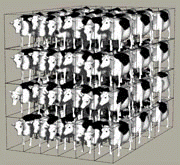Department of Animal Science
Date of this Version
1986
Abstract
A long term breeding program has been designed to take advantage of the heterosis available in a six breed composite while developing a cow which can reproduce on crop residue. A controlled natural selection method has been developed for those reproductive traits which did not lend themselves to objective measurement. Reproductive efficiency and feed conversion will always be desirable traits in beef cattle. Intensive selection pressures were applied to the above traits during the initial generations of crossing to form the composite. Culling rates of 70% were used in the initial and backcross generations. The effectiveness of selection has been estimated by comparing the average reproductive rate of all the FI cows to that observed in the composite. Correlated responses to selection for reproduction have been observed between the reproductive traits and the production traits.


Comments
Published in 3rd World Congress on Genetics Applied to Livestock Production, edited by Gordon E. Dickerson and Rodger K. Johnson, 4 vols. (Lincoln: University of Nebraska Institute of Agriculture and Natural Resources, 1986). Copyright © 1986 Board of Regents University of Nebraska.